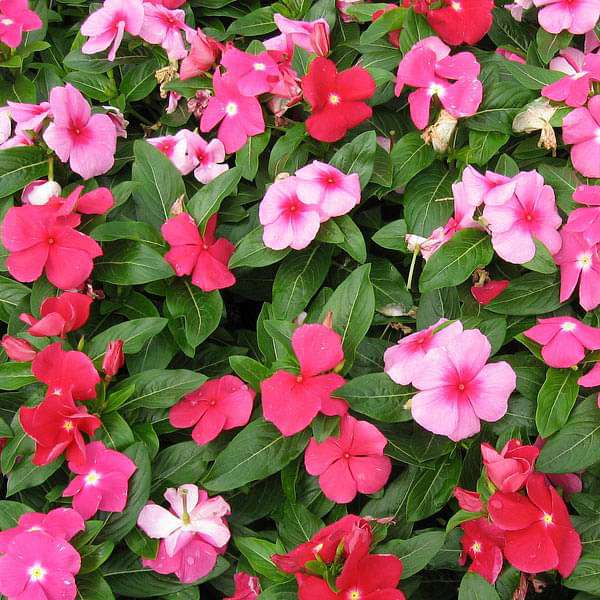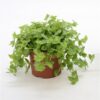Annual vinca (Catharanthus roseus) is a tropical perennial that is grown as an annual in most regions. It has flowers and foliage that resemble impatiens, but rather than being a shade lover, annual vinca is a perfect choice for sunny locations. Also known as Madagascar periwinkle, these aren’t the newest or flashiest annual flowers on the gardening scene, but recent cultivar developments warrant a closer examination of this common bedding plant. Horticulturists have been hard at work cultivating new colors in plants with showy flowers that are easy to start from seed. In a plant that was already reliably drought-tolerant and pest-free, what more could you ask? Plant vinca seedlings after the last frost date in your region.
The foliage is dark green and leathery. Depending on the variety, fast-growing vinca is 6 to 18 inches tall with a similar spread. Annual vinca plants bear single blooms with five petals that frequently touch or overlap from early summer until the first frost. Many varieties feature a contrasting eye. If you haven’t included vincas in your garden for a while, you should check out the expanded color palette that now includes blooms in every shade of the pink, rose, and lilac spectrum. No matter your preference, all are attractive to butterflies and are rabbit-resistant.
Annual Vinca Care
Don’t rush to put out vinca plants in the spring. Plants set out too early in cold, wet soil will deliver a sickly performance; after all, these are hot weather annuals. A safe bet is to plant your vincas around the same time you set out your tomato transplants: when evening temperatures average 60 degrees Fahrenheit. Full sun is best, although some afternoon shade is fine, especially in hot southern locations.
Annual vinca is best grown in a sandy loam soil in a full sun location. Although tolerant of drought, it will perform best with a weekly water soak rather than sprayed from overhead. Vincas are free-flowering and self-cleaning, and no deadheading is necessary.
This is one of the most carefree annual flowers you can grow, with few serious disease or insect problems. In poorly draining soil, stem rot and leaf spots may occur. Slugs and snails may also feast on the leaves.
Light
Annual vinca loves full sun. It will tolerate part shade but may become leggy if there is too much shade.
Soil
Vincas demand well-draining soil.3 Add compost or grit to your heavy soil; alternatively, plant vincas in raised beds or containers with a porous, well-draining potting mix.
Water
Watering too frequently is a common mistake with annual vinca. Water when the top inch of soil feels dry to the touch. Moderate weekly watering is ideal, but do not water at all if your garden is getting regular rainfall. This is a plant that thrives in dry soil.
Temperature and Humidity
This plant thrives in hot and humid weather. It will languish a bit if planted too early in the cool spring, and will begin to diminish as the weather cools in fall.
Fertilizer
Apply compost to the bed, or use a slow-release fertilizer at planting time. Container-grown plants need more frequent feedings, as nutrients leech from the soil as water drains.
Types of Annual Vinca
Top varieties of annual vinca include:
‘Cooler’ series: A good choice for gardeners with cool summers.
‘Heatwave’ series: Plants have a very compact growth habit.
‘Mediterranean’ series: Plants trail to 2 feet; use in containers and hanging baskets.
‘Pacifica’ series: An early bloomer.
‘Soiree Double White’: A novelty in the vinca world, this variety produces double flowers for a full, lush look.
‘Stardust series’: Flowers feature a white starburst in the center. Look for the All-America Selections’ award- winning “Stardust Orchid.”
Propagating Annual Vinca
This plant can be easily propagated by taking cuttings in early fall. Root them in water over the winter. Plant the rooted cuttings in potting soil in late winter and grow them into nursery plants to set out when the weather warms the following spring.
How to Grow Annual Vinca From Seeds
The newer vincas are easier to start from seed than their predecessors. They do take time to flower, however, so start seeds indoors 12 to 16 weeks before your average last frost. Cover the seeds enough to ensure darkness, and use supplemental heat if necessary to provide an ideal germination temperature of 75 degrees Fahrenheit. Make sure to harden off seedlings for a week to 10 days prior to planting in the garden.
Potting and Repotting Annual Vinca
Take advantage of the fast growth habit of vincas. Buy a six-pack of vinca plants as a filler for any blank sunny spot in the garden border where your perennials haven’t matured yet. Trailing annual vincas like the ‘Cora Cascade’ series doesn’t have a big footprint in the soil, but will spill onto pathways and peek through leggy shrubs to add a burst of color.
Bring out the contrasting eye of the vinca flower by pairing them with a flower that matches the flower’s eye. For example, you can plant white vincas with a burgundy eye alongside burgundy zinnias, or pair peach vincas with a red eye with dramatic wine-hued celosia plants.
The low-care nature of vinca plants helps them succeed in window boxes and other garden containers. Pair them with other heat and sun lovers like million bells, moss rose, lantanas, or penta flowers. These flowers will grow more prolifically as temperatures rise, keeping your sultry summer days full of color until fall.
How to Get Vinca to Bloom
Vinca is a prolific grower, but making sure it produces its darling, colorful flowers takes a couple of factors:
Sunlight. If your vinca isn’t blooming, thin it out a bit so the under layers get more sun.
Water. Check that the soil isn’t over-watered, and is well-draining. Vinca won’t bloom if its roots are waterlogged, so do not water unless the soil is dry.
As long as you’re addressing those two factors, vinca will bloom all season, no deadheading necessary.
Sale!
Vinca Plant
Original price was: ₹400.00.₹199.00Current price is: ₹199.00.
Common Names Annual vinca, Madagascar periwinkle, rosy periwinkle
Botanical Name Catharanthus roseus
Family Apocynaceae
Plant Type Herbaceous perennial, usually grown as an annual
Mature Size 6-18 in. tall, similar spread
Sun Exposure Full sun, part shade
Soil Type Sandy loam
Soil pH 6.0-7.0
Bloom Time June to frost
Flower Color White, pink, mauve, red
Hardiness Zones 9-11 (USDA), grown as an annual elsewhere
Native Area Madagascar
Only logged in customers who have purchased this product may leave a review.










Reviews
There are no reviews yet.